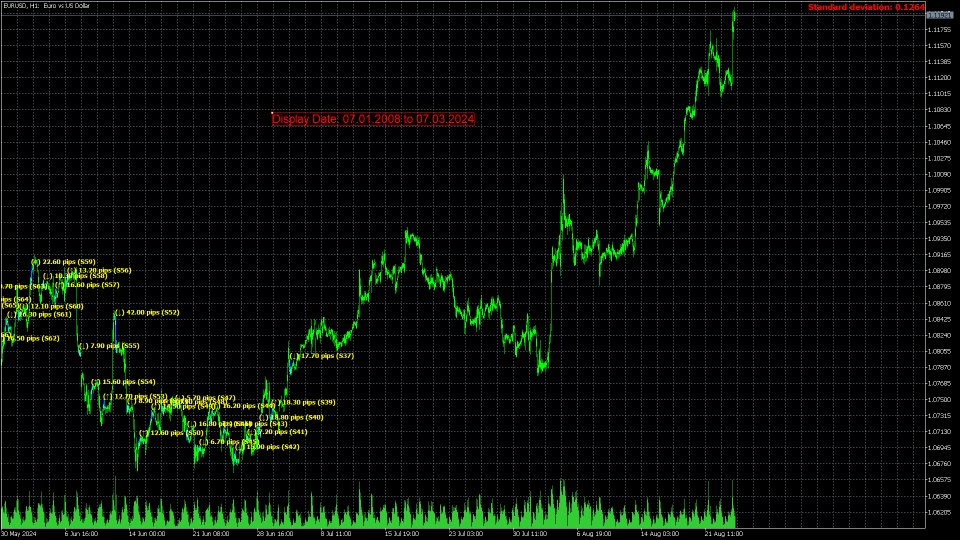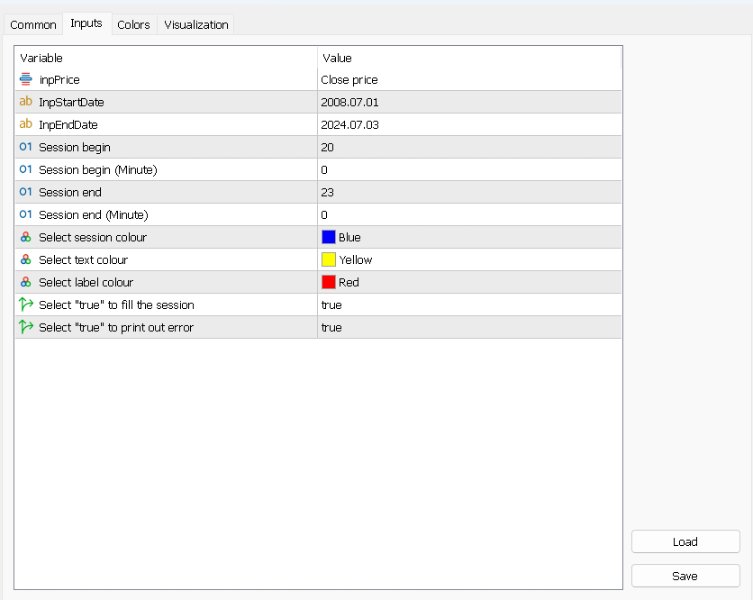
Session Normal Deviation Date Vary Analyzer: Consider the usual deviation of every bar’s worth (excessive, low, shut, open, weighted, median, and typical) inside outlined buying and selling classes and date ranges, offering detailed insights into worth volatility and market habits.
**Be aware:** When the buying and selling platform is closed, the indicator might not load accurately. To make sure it really works, chances are you’ll must load the indicator, unload it, after which load it once more.
**Be aware:** : This indicator can solely be used with historic knowledge. It doesn’t assist real-time knowledge evaluation.
**Be aware:** When switching to a distinct timeframe, it is advisable to modify forwards and backwards between timeframes to make sure that all knowledge masses correctly. This course of helps to fetch the mandatory historic knowledge, guaranteeing that calculations based mostly on this knowledge are correct.
Hyperlink to MT5 product: https://www.mql5.com/en/market/product/122236
Hyperlink to MT4 product: https://www.mql5.com/en/market/product/122260
Description:
The “Session Normal Deviation Date Vary Analyzer” is a classy analytical instrument crafted for merchants and analysts searching for to judge worth volatility throughout particular buying and selling classes inside a user-defined date vary. Not like conventional indicators that focus solely on excessive and low costs, this instrument supplies a complete evaluation based mostly on every bar’s worth, together with excessive, low, shut, open, weighted, median, and typical costs. This detailed method helps in understanding the usual deviation of worth actions, providing deeper insights into market volatility and habits over chosen intervals.
Key Options:
1. Customizable Time and Date Enter:
– Begin Time and Finish Time: Customers can specify the precise begin and finish occasions of the buying and selling session they want to analyze. This enables for exact examination of particular market hours, such because the New York session, or another related timeframe.
– Begin Date and Finish Date: Outline the vary of dates for evaluation, enabling customers to give attention to specific intervals, reminiscent of historic financial occasions or intervals of great market fluctuations.
2. Bar-Primarily based Evaluation:
– The instrument calculates commonplace deviation based mostly on numerous bar costs, together with excessive, low, shut, open, weighted, median, and typical costs. This method supplies a nuanced view of worth volatility by analyzing how every bar’s worth contributes to the general commonplace deviation inside the chosen session and date vary.
3. Enhanced Volatility Insights:
– By leveraging detailed worth knowledge, customers can acquire a deeper understanding of market volatility throughout particular classes. This function is especially useful for backtesting buying and selling methods or learning worth habits throughout important historic intervals.
4. Historic Information Evaluation:
– Customers can analyze how worth volatility has developed over time by analyzing historic knowledge. That is important for understanding market dynamics and assessing the influence of great occasions on buying and selling classes.
5. Software for Detailed Research:
– The instrument helps each short-term and long-term evaluation, making it appropriate for customers seeking to examine worth volatility over numerous intervals. Whether or not evaluating every day market actions or prolonged historic tendencies, the Session Normal Deviation Date Vary Analyzer supplies useful insights.
Sensible Use Case:
For a dealer aiming to evaluate the volatility of the New York buying and selling session throughout the monetary disaster of 2007-2009, the Session Normal Deviation Date Vary Analyzer could be utilized to enter the precise begin and finish occasions for the New York session and set the related date vary. The instrument will then calculate and supply the usual deviation of costs based mostly on every bar’s worth knowledge, providing an in depth view of how market volatility behaved throughout these turbulent occasions.
This instrument is designed for a variety of customers, from educational researchers to skilled merchants, by providing an in depth and customizable view of worth volatility throughout particular classes and date ranges. Its superior evaluation capabilities make it a useful asset for anybody concerned in worth evaluation and volatility evaluation.
Be aware: The indicator is optimized for timeframes of H4 and beneath.
Primary Inputs:
– InpPrice: Specifies the kind of worth used for traditional deviation calculation inside the chosen session and date vary. Choices embrace:
- Excessive: Use the best worth of every bar.
- Low: Use the bottom worth of every bar.
- Shut: Use the closing worth of every bar.
- Open: Use the opening worth of every bar.
- Weighted: Use the weighted worth of every bar.
- Median: Use the median worth of every bar.
- Typical: Use the standard worth of every bar.
– InpStartDate:Specify the beginning date for the evaluation interval.
– InpEndDate: Outline the ending date for the evaluation interval.
– SBegin (Dealer time): Units the beginning hour of the session in 24-hour format.
– SBeginMinute (Dealer time): Defines the beginning minute of the session.
– SEnd (Dealer time): Determines the ending hour of the session in 24-hour format.
– SEndMinute (Dealer time): Specifies the ending minute of the session.
– SColor: Chooses the colour for displaying the session on the chart.
– InpTextColor: Units the colour for the textual content displayed by the indicator.
– InpLabelColor: Defines the colour for labels inside the indicator.
– InpFill: Selects whether or not to fill the session space with colour.
– InpPrint: Determines whether or not to print error messages to the log.


